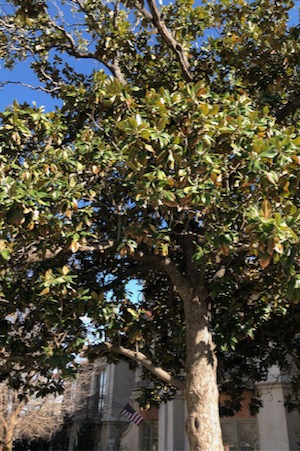
Some evergreen trees like this live oak may have dropped leaves but they should recover. Photo by John Kent.
March 16, 2021
The deep-freeze that pushed rare subzero temperatures into North Texas last month not only disrupted electric service and left death and destruction in its wake – it also stressed a lot of trees. But even after suffering through the brutal, sustained cold, a majority of area trees should leaf out as usual this spring, experts say.
“Most trees will be fine,” said Preston Willms, a certified arborist with the City of Dallas. “Ice is typically more damaging than cold, and we didn’t have much ice accumulation on our trees.”
In the Dallas-Fort Worth region, the storm’s most conspicuous effect on trees has been a dramatic leaf dump from area live oaks that has created thick mats and even drifts of browned leaves near the affected trees. Not to worry, Willms said – those oaks are probably fine.
“Live oaks normally replace their leaves going into the spring. It is just more abrupt this year,” he said. “If they are dropping leaves, that means they are growing leaves.”
“Live oaks normally replace their leaves going into the spring. It is just more abrupt this year,” he said. “If they are dropping leaves, that means they are growing leaves.”
 Shedded live oak leaves can be seen across the Metroplex. Photo by John Kent.
Shedded live oak leaves can be seen across the Metroplex. Photo by John Kent.
As for magnolia trees, the same advice holds true for these striking evergreens that may look more bare than normal. Willms said magnolias typically drop their leaves this time of year, but the transition is just usually more gradual.
"When I worked at the Arboretum, I would spend days raking and hauling magnolia leaves in the spring and fall."
 Healthy, established magnolias should recover, according the Preston Willms, city of Dallas arborist. Photo by Julie Thibodeaux.
Healthy, established magnolias should recover, according the Preston Willms, city of Dallas arborist. Photo by Julie Thibodeaux.
Willms said that Southern magnolias are a little more sensitive to the cold than live oaks but healthy established trees should recover.
However he added, "Their bloom might be weak this year due to the cold stress.”
Not all trees are out of the woods. Non-native species and young trees are the most susceptible to freeze damage, as are fruit trees, thin-barked varieties such as Japanese maples and more tropical specimens.
“It appears the palms were hit hard, although the sabals seemed to have fared much better than things like California fan palms,” said Courtney Blevins, Fort Worth regional forester with the Texas A&M Forest Service. “Southern pines, like slash pine, are looking bad in places but it’s very spotty. A brown one may have a healthy green one right next to it.”
Some of those more vulnerable trees could have suffered deep damage that may not be apparent until the summer. So tree experts are advising area residents to hold off on sawing or pruning for a while longer.
“Wait for the trees to put on new growth before pruning so any die-back is obvious,” Willms said, adding that proper watering and fertilization can help ease stress on the trees.
“Wait for the trees to put on new growth before pruning so any die-back is obvious,” Willms said.
The importance of keeping trees unstressed cannot be overstated, Blevins said.
“There’s not a lot to be done to help trees recover. We just have to wait and see what things look like as spring comes. Healthy trees should fully leaf out,” he said. “There may be some cases of frost cracks – which is freeze damage – to the trunk, but it’s not usually serious. As with all trees, reducing stress is the key to health and growth. That said, once the summer heat really kicks in, some supplemental watering may be helpful, but don’t overdo this.”
Trees weakened by stress, cold or otherwise, are generally more susceptible to insect infestation and disease. If you think your tree has a problem, you can contact a certified arborist to come take a look. Search for one by location at TreesAreGood.org
Because widespread losses from the freeze are not expected, no formal post-freeze assessment by state or local agencies is anticipated. Even so, arborists will be on the lookout for problems. “Each of our regional foresters has been asked to make notes of their observations for different species, both now and a couple months down the road,” Blevins said.
Because widespread losses from the freeze are not expected, no formal post-freeze assessment by state or local agencies is anticipated.
RELATED ARTICLES
Cactus among casualties of Texas’ Big Chill
Invasive beetles could devastate North Texas trees
Climate change is affecting Texas native plants, says prof
Stay up to date on everything green in North Texas, including the latest news and events! Sign up for the weekly Green Source DFW Newsletter! Follow us on Facebook and Twitter. Also check out our new podcast The Texas Green Report, available on your favorite podcast app.









